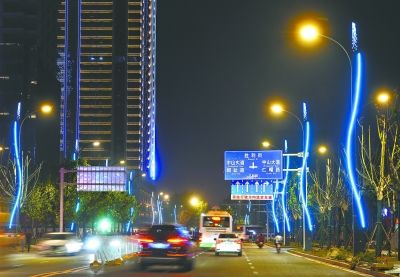Lamps and lanterns of the cooling
- 2020-05-18
- Views:0
Lamps and lanterns of the cooling
(Summary description)
- Categories:NEWS
- Author:
- Origin:
- 2020-05-18
- Views:0
As we all know, LED, a Light Emitting Diode, is a solid-state semiconductor device that can directly transform electrical energy into Light energy. The heart of the LED is a semiconductor chip. One end of the chip is attached to a bracket, which is a negative pole, and the other end is connected to the positive pole of the power supply. The whole chip is sealed with epoxy resin.
A semiconductor chip consists of two parts, one of which is a p-type semiconductor in which holes dominate, and the other end is an n-type semiconductor in which electrons dominate. But when the two semiconductors are connected, they form a "p-n junction" between them. When a current is applied to the chip through a wire, the electrons are pushed into the p-region, where they merge with holes and emit energy as photons, which is how leds emit light. And the wavelength of light, which determines the color of light, is determined by the material that forms the p-n junction.
In the process of LED converting electrical energy into light energy, when the current flows through LED components, the temperature of PN junction will rise, forming the so-called luminous heat, that is, the higher the current is, the higher the temperature is, the higher the brightness of the light will be. Seeing this, many people may say, in this case, why should we control the temperature of LED?
To understand the problem, let's take a look at how high temperatures can affect leds and LED lighting.
The influence of temperature on LED
- the LED is mainly composed of stents, silver glue, wafer, gold (copper), which is composed of epoxy resin, which in addition to support and epoxy resin, the other three kinds of material damage can lead to the LED straight to stop working, and high temperature, at the right moment is the bane of the above three kinds of material, under the environment of high temperature of LED light failure will increase, and reduce the service life of LED, can the person have a more even for a moment the gold (copper) burning result in LED straight damage.
(2) single LED can not directly meet the needs of use, often accompanied by LED power supply (drive), the power supply itself is a heating body, it has its own temperature requirements, if the temperature is too high, will cause the loss of power supply or even damage, so that LED lamps can not work normally.
Therefore, it is urgent to solve the temperature problem of LED and LED lamps, that is, heat dissipation.
The cooling principle
1 the conduction
It is well known that heat can be transmitted through a medium from a place where the temperature is too high to a place where the temperature is too low. In this case, the conductivity of the material, the thermal resistance caused by the structure of the radiator, and the shape or size of the radiator may interfere with the heat conduction.
2 radiation
High school physics teachers tell us that heat goes up, actually this is called radiation, it is very limited to the surrounding environment and the material of the radiation body itself.
3 convection
The person that buys a building should hear the concept of one word building, the sale can say such building is very cool commonly, true so, so called convection is through the flow of gas or liquid will come hot, its heat dissipation speed depends on the speed of flow commonly
Scan the QR code to read on your phone

E-mail: info@tonghuilighting.cn
ADD: No. 1, Guiding Road, Licang District, Qingdao, Shandong, China
Tel: +86-532-80928966 +86-532-80925662


